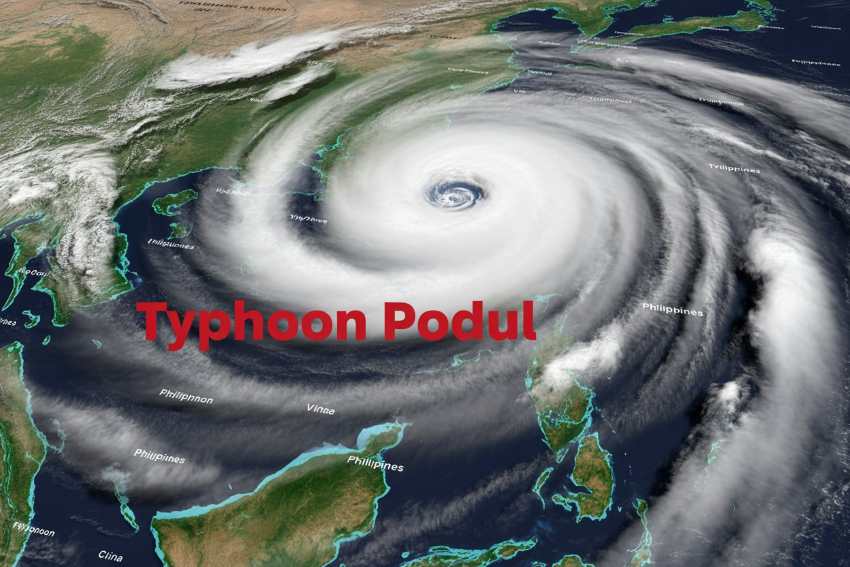Published on August 12, 2025
Typhoon Podul has rapidly intensified into a powerful storm, reaching maximum sustained winds of 130 km/h (81 mph). As it moves west-northwest at 30 km/h (19 mph), it is expected to make landfall near southeastern Taiwan on August 13, 2025. The storm’s destructive path is set to bring heavy rains, strong winds, and coastal flooding, significantly affecting Taiwan, Philippines, and southern China. Meteorologists are warning that Podul’s impact could lead to widespread travel disruptions, tourism shutdowns, and potentially devastating damage to infrastructure.
With the storm continuing to intensify, travelers and residents in these regions need to prepare for major disruptions. But how will this storm truly impact your travel plans? Let’s take a closer look.
Advertisement
Affected Regions
Taiwan
Advertisement
Taiwan is bracing for the full force of Typhoon Podul. Authorities have issued evacuation orders for over 2,000 residents from high-risk areas, particularly in Hualien and Kaohsiung counties. The storm is forecast to bring torrential rainfall of up to 600 mm (24 inches) in mountainous regions, increasing the risk of flash floods and landslides. Coastal areas, especially on Taiwan’s eastern shore, are expected to experience storm surges, with waves rising above 6 meters.
For travelers, the situation is dire. Popular tourist attractions in Taiwan, such as the Taroko Gorge and Alishan, are under threat of being closed or made inaccessible due to the extreme weather. Local airports in southern Taiwan, including Taitung, are already preparing for major disruptions, including possible flight cancellations and delays. The region’s public transportation system will also face significant setbacks, with train services and buses potentially suspended or rerouted. With these conditions, travelers should be prepared for flight cancellations, difficulty accessing destinations, and potential delays in their travel schedules.
Philippines
As Typhoon Podul continues its path westward, the Philippines, particularly the Bicol and Visayas regions, are bracing for severe weather. Over 50 flights have already been canceled, with more likely to follow as the storm moves closer to the country. Areas such as Batanes, Tuguegarao, and Laoag are expected to experience widespread rainfall, strong winds, and potential storm surges, with flash floods and landslides a growing concern.
For the tourism industry in the Philippines, the storm’s impact is already being felt. Resorts in popular destinations like Cebu, Bohol, and Boracay are facing cancellations, and some are closing their doors to ensure guest safety. The Department of Tourism has advised tourists to reconsider their travel plans or postpone visits to vulnerable areas, especially as power outages and transportation disruptions are expected to increase.
Despite the storm’s expected weakening, the Philippines will continue to face heavy rainfall and strong winds for days, with significant effects on tourism, including the closure of attractions and the suspension of tours and activities. Travelers planning to visit these regions should monitor weather updates and stay in touch with their accommodations and airlines for rescheduling options.
China
China’s southern provinces, particularly Guangdong and Hainan, are preparing for Typhoon Podul’s aftermath. Although the storm is expected to weaken after it makes landfall in Taiwan, the storm’s remnants will still bring significant rainfall, strong winds, and flooding to southern China. The city of Guangzhou, along with the island of Hainan, is on high alert for coastal erosion and disruption to daily life. The storm’s winds are expected to reach speeds of up to 185 km/h (115 mph) near its center, causing extensive damage to infrastructure and local businesses.
For travelers in China, the impact will be felt in the form of significant delays. Flights to and from southern China are expected to be canceled or delayed, with major airports in Guangzhou and Shenzhen facing operational disruptions. Train services, ferry routes, and highways in affected regions may be suspended, causing further delays for anyone planning to travel within China or from neighboring countries. Tourism in Hainan, a popular beach destination, is likely to suffer, as tourists will be advised to avoid coastal areas during the storm.
Wind Speeds and Intensity
Typhoon Podul has reached a peak intensity of 185 km/h (115 mph), which places it within the lower range of Category 2 on the Saffir-Simpson scale. While the storm is expected to weaken slightly as it makes landfall, its size and strength still pose a major threat to the affected regions.
The intense winds will cause widespread damage, particularly to buildings that are not built to withstand such strong gusts. Trees are expected to be uprooted, power lines brought down, and significant debris scattered across affected areas. Coastal regions are at a high risk of flooding due to storm surges, and transportation networks will likely be severely disrupted as the storm progresses.
Potential Impacts
- Rainfall: The extreme rainfall associated with Typhoon Podul will cause flash floods, particularly in the mountainous areas of Taiwan, the Philippines, and southern China. Flooding is expected to be most severe in low-lying coastal areas, where rivers may overflow.
- Wind Damage: The storm’s powerful winds are set to cause extensive damage to buildings, homes, and infrastructure. Power outages will likely be widespread, and fallen trees and debris will obstruct roads, making travel dangerous and difficult.
- Coastal Erosion: Areas along Taiwan’s eastern coast and the Philippines’ coastal regions face the risk of storm surges, exacerbating coastal erosion. This could lead to infrastructure damage, including the destruction of piers, bridges, and roads vital for local economies, particularly in tourism-driven areas.
- Transportation Disruptions: Travel across the affected regions will be severely disrupted. Flights in and out of Taiwan, the Philippines, and southern China will be delayed or canceled. Road and rail travel will also be impacted as authorities close routes and prepare for potential landslides and flooding.
Impact on Travel and Tourism
Typhoon Podul will have an immense impact on the tourism industry in Taiwan, the Philippines, and China. For Taiwan, popular tourist sites will be closed, and many travelers will face canceled flights, disrupted accommodations, and significant delays. The island’s status as a top travel destination for international visitors will likely suffer a sharp decline during this storm.
In the Philippines, the typhoon is expected to affect tourism in some of its most iconic spots, such as Boracay and Cebu. Resort closures, flight cancellations, and canceled tours are likely to cause widespread disruptions, as travelers cut short their trips or postpone future bookings.
For China, southern provinces like Guangdong and Hainan, which are often bustling with tourists during the summer months, will face beach resort closures, canceled flights, and significant disruptions to both international and domestic tourism.
The impact on tourism is expected to last well beyond the immediate storm, as recovery efforts will take time to restore transportation links, rebuild damaged infrastructure, and reassure travelers that the regions are safe for future visits.
Preparedness and Response
As Typhoon Podul approaches, authorities in Taiwan, the Philippines, and China are on high alert. Emergency response plans are in place to manage evacuations, provide shelter, and ensure the safety of residents and travelers. Governments are urging people to stay informed about evacuation routes and safety measures, and to prepare for power outages, flooding, and disruptions to public services.
Travelers are advised to check with airlines, hotels, and transportation services for real-time updates and to reconsider their travel plans if they are planning to visit these regions. It’s essential to stay connected with local authorities for any evacuation notices or safety guidelines during the storm.
Future Projections
While Typhoon Podul is expected to weaken after landfall in Taiwan, its effects will continue to be felt in the Philippines and southern China. Travelers are advised to follow safety instructions closely and expect travel delays for several days after the storm has passed.
As regions begin the recovery process, tourism businesses will focus on rebuilding and restoring services. However, it may take weeks or even months for the full impact to be addressed, particularly in heavily damaged coastal regions. Travelers are encouraged to plan carefully and consider alternative destinations if they are traveling to these areas in the coming weeks.
Advertisement
Tags: China typhoon effects, Philippines tourism impact, Taiwan travel disruptions, Typhoon Podul, Typhoon Podul travel delays
Advertisement
Tags: China typhoon effects, Philippines tourism impact, Taiwan travel disruptions, Typhoon Podul, Typhoon Podul travel delays
I want to receive travel news and trade event update from Travel And Tour World. I have read Travel And Tour World’sPrivacy Notice.
Wednesday, August 13, 2025
Wednesday, August 13, 2025
Wednesday, August 13, 2025
Wednesday, August 13, 2025
Tuesday, August 12, 2025
Tuesday, August 12, 2025
Wednesday, August 13, 2025
Wednesday, August 13, 2025




